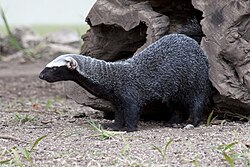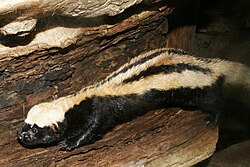| Ictonychinae | |
|---|---|
 | |
| Greater grison (Galictis vittata) | |
| Scientific classification | |
| Kingdom: | Animalia |
| Phylum: | Chordata |
| Class: | Mammalia |
| Order: | Carnivora |
| Family: | Mustelidae |
| Subfamily: | Ictonychinae Pocock, 1921 [1] |
| Genera | |
| Synonyms | |
| |
Ictonychinae is a subfamily of the mammal family Mustelidae found mainly in the Neotropics (three species) and Africa (three species), with one Eurasian member. It includes the grisons, Patagonian weasel, striped polecats, African striped weasel, and marbled polecat. [2] [3] These genera were formerly included within a paraphyletic definition of the mustelid subfamily Mustelinae. [4]
Contents
Most members have a mask-like bar or larger dark marking across their faces; the African representatives of the group are striped. A defense mechanism common to the group is use of a chemical spray similar to (but not necessarily as strong as) that of skunks.



